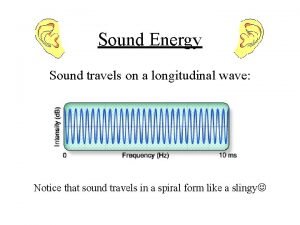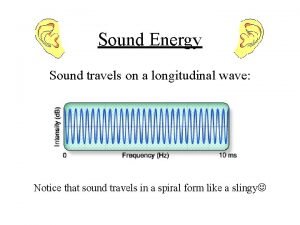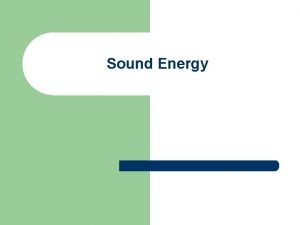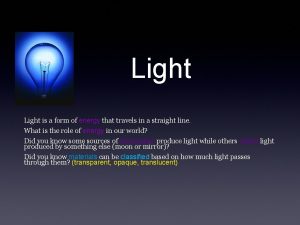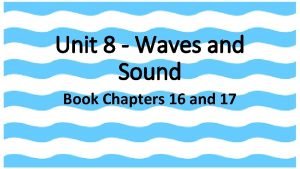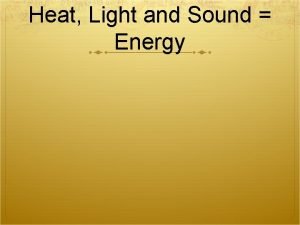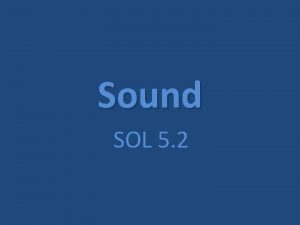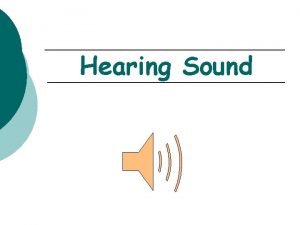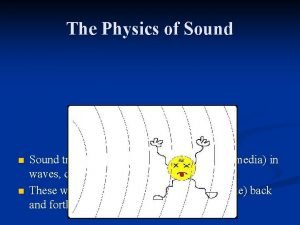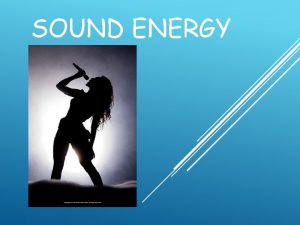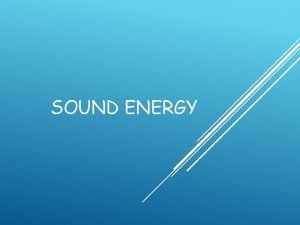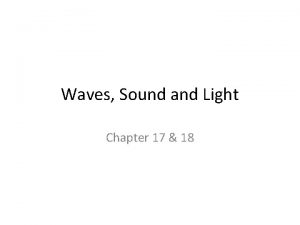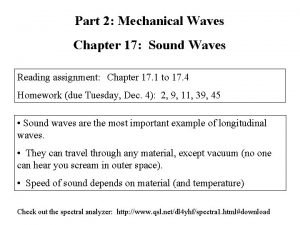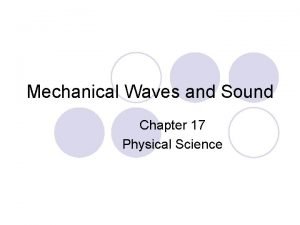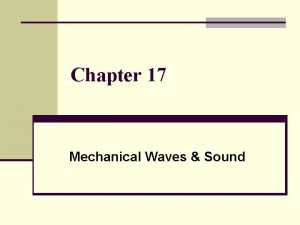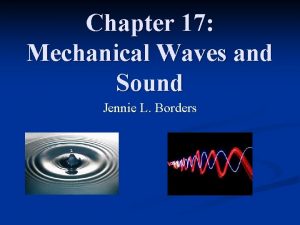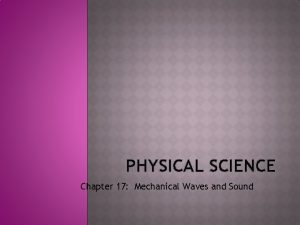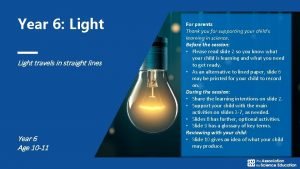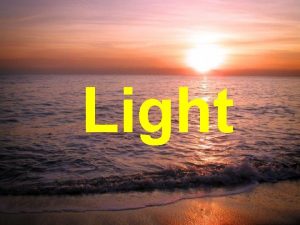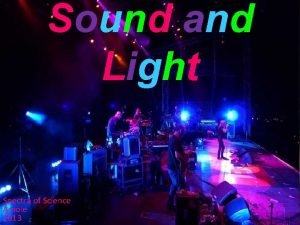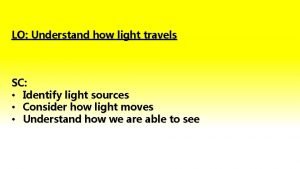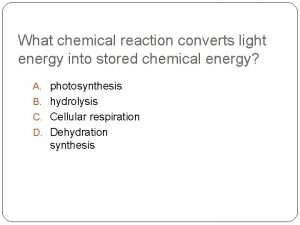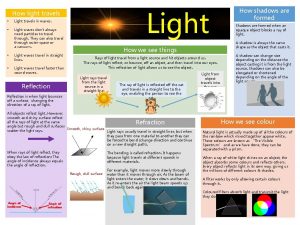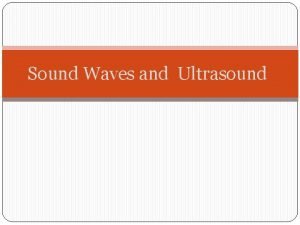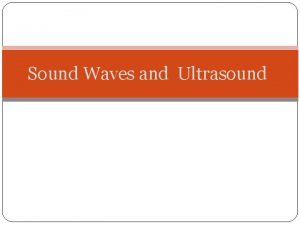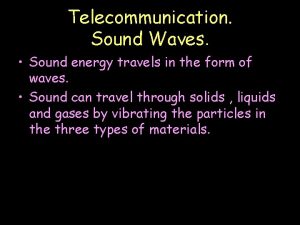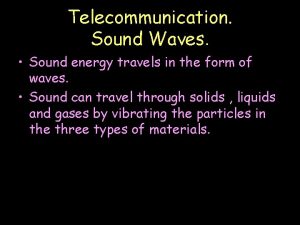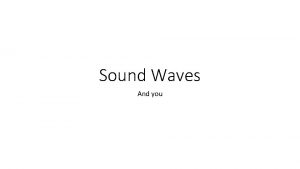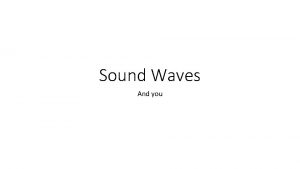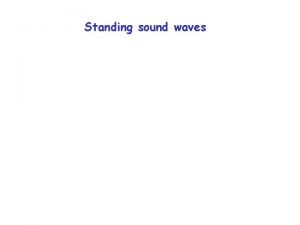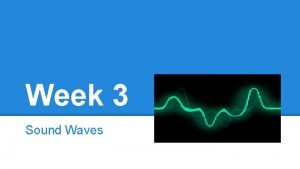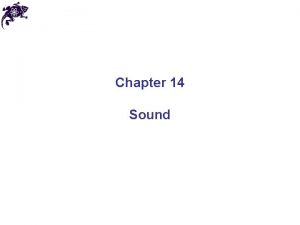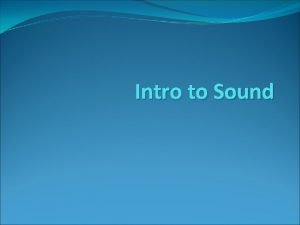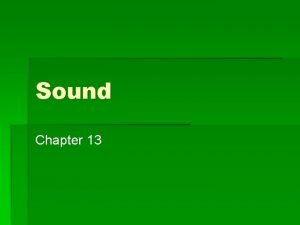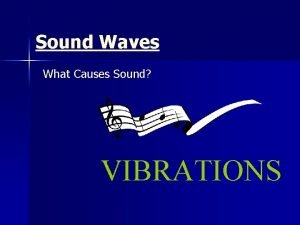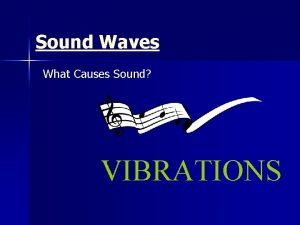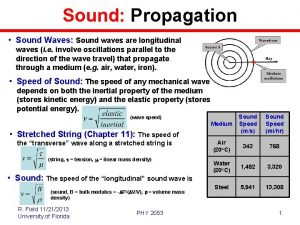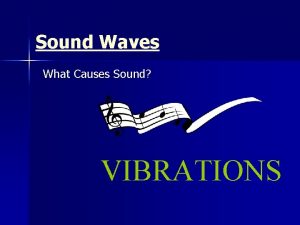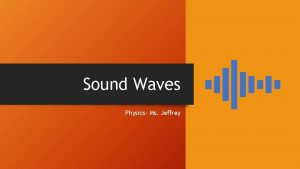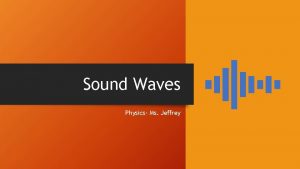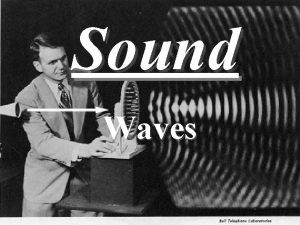Unit 4 Waves Sound and Light Energy travels





















































- Slides: 53

Unit 4: Waves, Sound and Light Energy travels by either: 1. particles or 2. waves. I could throw an object at you or shout at you to get your attention.

Waves are periodic repetitions like Simple Harmonic Motion.

Wave Terminology A wave is a disturbance (vibration) that carries energy from one point to another without the transmission of matter (particles).

A cycle is a complete path or oscillation. Ex. A swinging mass goes through one complete swing and comes back to its starting point. Period (T) is the amount of time ( in seconds) it takes for a vibrating object to go through one oscillation or one cycle. T = time cycles

Frequency (f) is the number of cycles or oscillations in one second. f = cycles time NOTE: Period and frequency are reciprocals.

Frequency is measured in Hertz (Hz), after Heinrich Hertz (1857 -94), so: 1 cycle/second = 1 Hertz Ex. 1: A pendulum moves through 12 complete swings (cycles) in 6 seconds. What is the period of the vibration? What is the frequency? Ex. 2: The tines of a tuning fork vibrate through 512 cycles in 2 s. Determine the frequency and the period of the vibration. Text page 389 #’s 1 -3

2 Classifications of Waves (vibrations) A transverse wave- the particles of the medium vibrate perpendicular to the direction in which the energy is traveling in the medium. Tops of the waves are called crests. Bottom of the waves are called troughs. The distance between adjacent crests (or adjacent troughs) is called a wavelength (λ). The maximum distance from the rest position is the amplitude, A.

A longitudinal wave - the particles of the medium vibrate parallel to the direction in which the energy is traveling in the medium. Example: Sound wave The areas where the particles of the medium are bunched together are called COMPRESSIONS. The areas where the particles of the medium are spread apart are called RAREFACTIONS.



Example 1: A boat is at anchor and is bobbing in the swell. A sailor notices that the boat bobs up and down 18 times in 20 s. Calculate the period and the frequency. (T=1. 1 s) (f=0. 9 Hz)

Example 2: VOCM broadcasts using a carrier-wave frequency of 590 k. Hz. Calculate the period of the wave and the number of complete cycles that occur during the broadcast of a 3 -minute song. (T=1. 7 x 10 -6 s) (#of cycles in 180 s = 1. 06 x 108)

The Universal Wave Equation relates the speed, v , at which a wave travels to the wavelength, λ, and the frequency, f. V=d t Sub in λ for d we get, V = f λ Sub in (The Universal Wave Equation) v = speed (m/s), f = frequency (Hz), λ = wavelength (m)

Example: What is the frequency of sound sent through glass if the wavelength is 2. 0 m and the speed of sound in glass is 5000 m/s? v(glass) = 5000 m/s , λ = 2. 0 m , f = ? v=fλ f = 5000 m/s = 2500 Hz 2. 0 m

Example : If you attach one end of a slinky spring to a wall and produce 0. 70 m long waves with a frequency of 3. 0 Hz, what is the speed of the waves in the slinky? (2. 1 m/s)

Example : The sound waves produced by a tuning fork have a wavelength of 1. 3 m and travel at a speed of 340 m/s. What is the period of the waves? (3. 8 x 10 -3 s)

Practice 1. 2. 3. 4. 5. 6. A wave has a frequency of 2. 5 Hz and wavelength of 0. 60 m. Calculate the speed. A wave has a period of 0. 020 s and a wavelength of 0. 0030 m. Calculate the speed. Calculate the wavelength of a wave with a period of 0. 30 s and a speed of 2. 2 m/s. Calculate the wavelength of a wave with a speed of 20. 0 m/s and a period of 0. 22 s. What is the period of a wave with a wavelength of 2. 2 m and a speed of 520 000 m/s ? What is the frequency of a wave with a wavelength of 0. 0030 m and a speed of 3. 00 x 108 m/s ?

Answers: 1. 1. 5 m/s 2. 0. 15 m/s 3. 0. 66 m 4. 4. 4 m 5. 4. 2 x 10 -6 s 6. 1. 0 x 1011 Hz

Solving Word Problems with Waves 1. Twelve waves are observed to pass by a wharf post in a time of 10 seconds. If the distance from crest to crest is approximately 1. 6 m, what is the speed of the waves? (1. 9 m/s) 2. The centre of the boat is 28 m from the beacon on the buoy. If the buoy rocks up and down 45 times in one minute, what is the speed of the waves? (8. 4 m/s) 3. Radio waves travel at the speed of light, 3. 00 x 108 m/s. FM radio signals have frequencies ranging from 88. 0 MHz to 108 MHz. What are the wavelengths of the signals? (2. 8 m to 3. 4 m) 4. The S waves produced in an earthquake travel at 5500 m/s and the P waves produced in the same earthquake travel at 8500 m/s. If the same seismic station detects the arrival of P waves from a distant earthquake 93 s before the S waves. How far away is the Earthquake? (1414492 m = 1400 km) (S, or surface waves, tend to travel along the Earth's crust and are transverse. P, or pressure waves, are longitudinal. )

Example 2: The centre of the boat is 28 m from the beacon on the buoy. If the buoy rocks up and down 45 times in one minute, then what is the speed of the waves? (8. 4 m/s)

Example 3: Radio signals travel at the speed of light, which is approximately 3. 00 x 108 m/s. FM radio signals have frequencies ranging from 88. 0 MHz to 108 MHz. What are the wavelengths of the signals? (2. 8 m to 3. 4 m)

Example 4: The S waves produced in an earthquake travel at 5500 m/s and the P waves produced in the same earthquake travel at 8500 m/s. If the same seismic station detects the arrival of P waves from a distant earthquake 93 s before the S waves. How far away is the Earthquake? (S, or surface waves, tend to travel along the Earth's crust and are transverse. P, or pressure waves, are longitudinal. ) (8500 m/s) t = d = (5500 m/s) (t+93 s) 8500 t = 5500 t + 511500 3000 t = 511500 t = 170. 5 s Now, d = (8500 m/s) (170. 5 s) = 1449250 m = 1400 km

Properties of Waves Resonance, Reflection, Interference, etc.

RESONANCE - the phenomenon when the vibration frequency of object A matches the natural vibration frequency of object B, and object B is caused to vibrate. Object A transfers Energy to Object B Every object has a natural frequency which it wants to vibrate at. We call this its resonant frequency, (frequency it best receives energy). If a swing takes 2 s to complete one cycle (swing) then its natural frequency is ½ Hz and for maximum transfer of energy to swing you must push it with a frequency of ½ Hz.

Tacoma Narrow Bridge Collapse: Was it due to resonance ? Youtube video Fig. 12. 19 Other examples: • 2 tuning forks • Army marching across bridge • Electronic circuit of a radio

Reflection of Waves When a pulse of a wave is sent through a medium (ex. string) and meets a different medium it reflects. The reflection type depends on the new medium. Waves in One-Dimension When the far end of the medium is fastened tightly to something we say that such a medium has a fixed end. Fixed end reflection inverts the wave. When the far end of the medium is free to move we say that such a medium has a free end. (Ex. heavy string attached to light string) Free end reflection is not inverted.


Waves In Phase Waves Out of Phase

Interference Waves can overlap (pass thru) constructively or destructively. Constructive interference occurs at a point when two waves have displacements in the same direction. The amplitude of the combo wave is larger than either individual wave. Destructive interference occurs at a point when two waves have displacements in opposite directions. The amplitude of the combo wave is smaller than that of the biggest wave.

Principle of Superposition The Principle of Superposition states: if two or more waves occur in a medium, the resultant wave is the sum of the individual waves. Superposition can involve both constructive and destructive interference at the same time (but at different points in the medium).

Interference Constructive Destructive

Wave shape depends on source Waves from a point source are circular. Ex. Dropping a pebble into water. Waves from a linear source are straight and parallel. Linear source Point source

Wavefront and Waveray Wavefront – the shape of a continuous crest or trough. Waveray - a ray perpendicular to a wavefront, which is used to indicate the direction of the wave’s energy of motion.

Light as a Wave ? ?

PRODUCTION OF LIGHT 1) Incandescence- light emitted due to high temperature. Ex: incandescent light bulb, glow of stove element 2) Fluorescence- light emitted when an object is struck by high energy particles. Ex: fluorescent lights, northern lights 3) Phosphorescence- like fluorescence except the object continues to emit light for a while after being struck by the energy source. Ex: luminous watch dial 4) Chemiluminescence- reaction of chemicals produce light, without an increase in temperature. Ex: glow stick, firefly

Properties of Light Read pp. 390 -400. Rectilinear Propagation – travels in a straight line speed of light, c = 3. 00 x 10 8 m/s Reflection – light bounces back into same medium transmission – light passing into a new medium Refraction – bending of transmitted light as it travels from one medium to another.

Laws of Reflection for Flat Surfaces 1) The angle of incidence = the angle of reflection (θi= θr). Note: angle measured from the normal, ie. perpendicular line from surface. 2) Both the incident and reflected rays are in the same plane.

Refraction: the bending of a light wave when the wave passes from one medium to another of “different speed”. ‘medium’ refers to the type of substance the wave is passing through – air, glass, water. It is the “change in speed” (change in medium) that results in the change in the path of the wave.

Normal: Perpendicular line to surface from which angles are measured.

From looking at refraction diagrams, 1. When entering into a slower medium, the wave refracts towards the normal. 2. When entering into a faster medium, the wave refracts away from the normal.

Refraction is caused by a change in speed. Speed of light in solids < liquids < gases (glass) < (water) < (air) water

Index of Refraction The index of refraction is the ratio of the speed of light in a vacuum to the speed of light in the other medium. It also indicates how much the light will refract, ie. how much the angle of it’s path changes. In mathematics, where n = the index of refraction of the medium v = the speed of light in the medium c = the speed of light in a vacuum = 3. 0 x 108 m/s

Index Of Refraction Medium Vacuum Air (STP) Water (20º C) Glass Diamond n 1 1. 00029 1. 33 1. 36 ~1. 5 2. 42

Example 1: Calculate the index of refraction of a diamond if the speed of light in a diamond is 1. 24 x 108 m/s. (n = 2. 42)

Example 2: Calculate the speed of light in a hypothetical material if its refractive index is 0. 90. ( v = 3. 3 x 108 m/s) Does this answer seem reasonable? Text P. 404 #’s 1 & 2

Snell’s Law Amount of refraction (ie. angle change) depends on: 1. 2. the index of refraction of the two media the angle of incidence This relationship is known as Snell’s Law: n 1 sin 1θ=n 2 sinθ 2

i n 1 sinθ 1=n 2 sinθ 2 r ni nr where θ 1 = the angle of incidence θ 2 = the angle of refraction n 1 = index of refraction for incident medium n 2 = index of refraction for refracting medium

Example 1: A ray of light passes from air ( n=1. 00) to water (n =1. 33), with an angle of incidence of 30°. What is the angle of refraction? na x sin 300 = nw x sin Ɵw 1. 00 x ( 0. 5) = 1. 33 x sin Ɵw 0. 5 = sin Ɵw 1. 33 sin Ɵw = 0. 3759 Ɵw = sin -1 ( 0. 3759) Ɵw = 220

Example 2: Calculate the index of refraction for an incident substance where the angle of incidence is 30°, the angle of refraction is 50. 0°, and the index of refraction of the second substance is 1. 50. ( n 1 = 2. 3 )

Review – don’t write out. Lets do together. 1. When light passes from a more optically dense medium into a less optically dense medium, it will bend _______ (towards, away from) the normal. 2. When light passes from a medium with a high index of refraction value into a medium with a low index of refraction value, it will bend _______ (towards, away from) the normal. ** The higher the value of n the more optically dense the medium is, therefore the slower the light moves. . . causing the light ray to move towards the normal when going from a high n value to a low one and away from the normal when going from a low n value to a higher one.

3. In each diagram, draw the "missing" ray (either incident or refracted) in order to appropriately show that the direction of bending is towards or away from the normal.

4. Arthur’s method of fishing involves spearing the fish while standing on the shore. The actual location of the fish is shown in the diagram below. Because of the refraction of light, the observed location of the fish is different than its actual location. Where does the fish appear to be? Must Arthur aim above or below where the fish appears to be in order to strike the fish?

5. A ray of light in air is approaching the boundary with a layer of crown glass at an angle of 42. 0 degrees. Determine the angle of refraction of the light ray upon entering the crown glass and upon leaving the crown glass. 1 sin 42 = n 2 sin Θ 2 = 1 sin Θ 3 = 42 Practice: P. 438 #’s 64, 66, 69, 60
 Similarities of mechanical and electromagnetic waves
Similarities of mechanical and electromagnetic waves Light is electromagnetic wave true or false
Light is electromagnetic wave true or false What type of waves are sound waves? *
What type of waves are sound waves? * Sound is a longitudinal wave
Sound is a longitudinal wave Sound energy
Sound energy Sound is a longitudinal wave
Sound is a longitudinal wave L
L A form of energy that travels into a straight line
A form of energy that travels into a straight line Soundwaves unit 21
Soundwaves unit 21 Sound waves unit 8
Sound waves unit 8 Heat light and sound energy
Heat light and sound energy Do light waves transfer energy
Do light waves transfer energy Compare and contrast p waves and s waves using venn diagram
Compare and contrast p waves and s waves using venn diagram Light light light chapter 23
Light light light chapter 23 Light light light chapter 22
Light light light chapter 22 Light light light chapter 22
Light light light chapter 22 High and low frequency waves
High and low frequency waves Energy that travels through
Energy that travels through Short wave vs long wave radiation
Short wave vs long wave radiation Mechanical waves and electromagnetic waves similarities
Mechanical waves and electromagnetic waves similarities Mechanical and electromagnetic waves similarities
Mechanical and electromagnetic waves similarities Seismic waves
Seismic waves What do all waves transmit
What do all waves transmit Constructive
Constructive Speed of sound through steel
Speed of sound through steel Echolocation
Echolocation Lrefraction
Lrefraction What can sound travel through
What can sound travel through Sound travels through?
Sound travels through? Ultrasound beam attenuation
Ultrasound beam attenuation How sound travels
How sound travels Which medium sound travels faster
Which medium sound travels faster Mechanical waves
Mechanical waves Chapter 17 mechanical waves and sound wordwise answer key
Chapter 17 mechanical waves and sound wordwise answer key Chapter 17 mechanical waves and sound
Chapter 17 mechanical waves and sound Chapter 17 mechanical waves and sound
Chapter 17 mechanical waves and sound Example of mechanical wave
Example of mechanical wave Chapter 17 mechanical waves and sound
Chapter 17 mechanical waves and sound Light travels in straight lines
Light travels in straight lines A ray of light travels from an optical denser
A ray of light travels from an optical denser How does light travels
How does light travels Light travels 3 00 000 km/s. is it velocity or speed
Light travels 3 00 000 km/s. is it velocity or speed Light can travels from the sun toefl
Light can travels from the sun toefl Tachyonization
Tachyonization Picture how light travels
Picture how light travels Wave speed formula
Wave speed formula Light always travels in
Light always travels in How light travels diagram
How light travels diagram Examples of mechanical and electromagnetic waves
Examples of mechanical and electromagnetic waves Is a seismic wave mechanical or electromagnetic
Is a seismic wave mechanical or electromagnetic ________ converts light energy into chemical energy. *
________ converts light energy into chemical energy. * Photosynthesis transforms light energy into chemical energy
Photosynthesis transforms light energy into chemical energy Energy energy transfer and general energy analysis
Energy energy transfer and general energy analysis Energy energy transfer and general energy analysis
Energy energy transfer and general energy analysis




